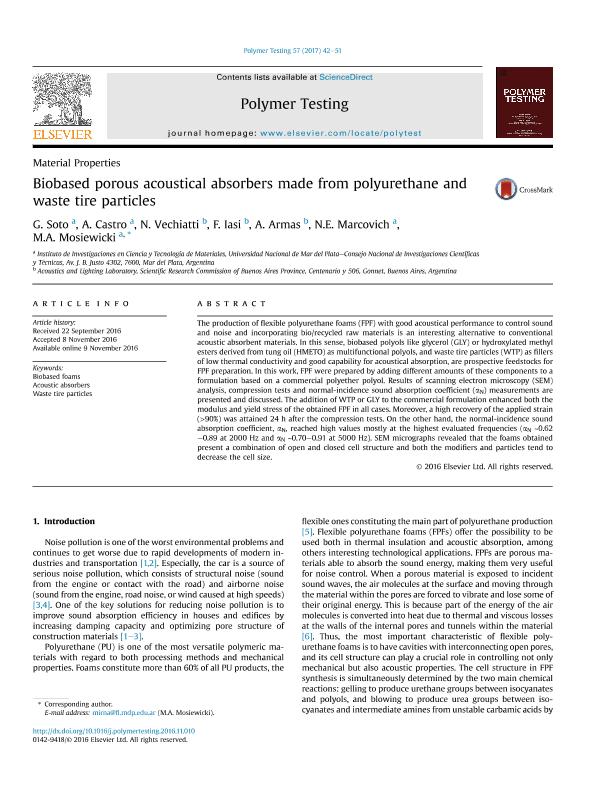Artículo
Biobased porous acoustical absorbers made from polyurethane and waste tire particles
Soto, Guillermo Daniel ; Castro, Anthony; Vechiatti, Nilda; Iasi, F.; Armas, A.; Marcovich, Norma Esther
; Castro, Anthony; Vechiatti, Nilda; Iasi, F.; Armas, A.; Marcovich, Norma Esther ; Mosiewicki, Mirna Alejandra
; Mosiewicki, Mirna Alejandra
 ; Castro, Anthony; Vechiatti, Nilda; Iasi, F.; Armas, A.; Marcovich, Norma Esther
; Castro, Anthony; Vechiatti, Nilda; Iasi, F.; Armas, A.; Marcovich, Norma Esther ; Mosiewicki, Mirna Alejandra
; Mosiewicki, Mirna Alejandra
Fecha de publicación:
09/11/2016
Editorial:
Elsevier
Revista:
Polymer Testing
ISSN:
0142-9418
Idioma:
Inglés
Tipo de recurso:
Artículo publicado
Clasificación temática:
Resumen
The production of flexible polyurethane foams (FPF) with good acoustical performance to control sound and noise and incorporating bio/recycled raw materials is an interesting alternative to conventional acoustic absorbent materials. In this sense, biobased polyols like glycerol (GLY) or hydroxylated methyl esters derived from tung oil (HMETO) as multifunctional polyols, and waste tire particles (WTP) as fillersof low thermal conductivity and good capability for acoustical absorption, are prospective feedstocks for FPF preparation. In this work, FPF were prepared by adding different amounts of these components to aformulation based on a commercial polyether polyol. Results of scanning electron microscopy (SEM) analysis, compression tests and normal-incidence sound absorption coefficient (alphaN) measurements arepresented and discussed. The addition of WTP or GLY to the commercial formulation enhanced both the modulus and yield stress of the obtained FPF in all cases. Moreover, a high recovery of the applied strain(>90%) was attained 24 h after the compression tests. On the other hand, the normal-incidence sound absorption coefficient, aN, reached high values mostly at the highest evaluated frequencies (alphaN ~0.62-0.89 at 2000 Hz and alphaN ~0.70-0.91 at 5000 Hz). SEM micrographs revealed that the foams obtained present a combination of open and closed cell structure and both the modifiers and particles tend to decrease the cell size.
Palabras clave:
Biobased Foams
,
Acoustic Absorbers
,
Waste Tire Particles
Archivos asociados
Licencia
Identificadores
Colecciones
Articulos(INTEMA)
Articulos de INST.DE INV.EN CIENCIA Y TECNOL.MATERIALES (I)
Articulos de INST.DE INV.EN CIENCIA Y TECNOL.MATERIALES (I)
Citación
Soto, Guillermo Daniel; Castro, Anthony; Vechiatti, Nilda; Iasi, F.; Armas, A.; et al.; Biobased porous acoustical absorbers made from polyurethane and waste tire particles; Elsevier; Polymer Testing; 57; 9-11-2016; 42-51
Compartir
Altmétricas



